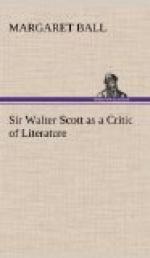Throughout his boyhood Scott read all the fairy tales, eastern stories, and romances of knight-errantry that fell in his way. When he was about thirteen, he and a young friend used to spend hours reading together such authors as Spenser, Ariosto, and Boiardo.[73] He remembered the poems so well that weeks or months afterwards he could repeat whole pages that had particularly impressed him. Somewhat later the two boys improvised similar stories to recite to each other, Scott being the one who proposed the plan and the more successful in carrying it out. With this same friend he studied Italian and began to read the Italian poets in the original. In his autobiography he says:[74] “I had previously renewed and extended my knowledge of the French language, from the same principle of romantic research. Tressan’s romances, the Bibliotheque Bleue, and Bibliotheque de Romans, were already familiar to me, and I now acquired similar intimacy with the works of Dante, Boiardo, Pulci, and other eminent Italian authors.” Writing some years later he remarked: “I was once the most enormous devourer of the Italian romantic poetry, which indeed is the only poetry of their country which I ever had much patience for; for after all that has been said of Petrarch and his school, I am always tempted to exclaim like honest Christopher Sly, ‘Marvellous good matter, would it were done.’ But with Charlemagne and his paladins I could dwell forever."[75] Scott learned languages easily, and he read Spanish with about as much facility as Italian. Don Quixote seems often to be the guide with whom he chooses to traverse the fields of romance.[76] In Scott’s boyhood one of his teachers noticed that he could follow and enjoy the meaning of what he read in Latin better than many of his school-fellows who knew more about the language, and it was the same all through his life—he got what he wanted from foreign literatures with very little trouble.
Scott constantly refers to the work of Percy, Warton, Tressan,[77] Ritson, and Ellis, in the study of ancient romances, but in editing Sir Tristrem he made one part of the field his own, and became the authority whom he felt obliged to quote in the Essay on Romance.
Thomas the Rhymer of Erceldoune was at first an object of interest to Scott because of the ballad of True Thomas and the traditions concerning him that floated about the countryside. The “Rhymer’s Glen” was afterwards a cherished possession of Scott’s own on the Abbotsford estate. In the Advocates’ Library at Edinburgh, of which Scott was in 1795 appointed a curator, was an important manuscript that contained among other metrical romances one professing to be a copy of that written by Thomas of Erceldoune on Sir Tristrem. From a careful piecing together of evidence furnished by this poem and by Robert of Brunne, with the assistance of certain legal documents which supplied dates, Scott built up about the old poet a theory that he elaborated in




